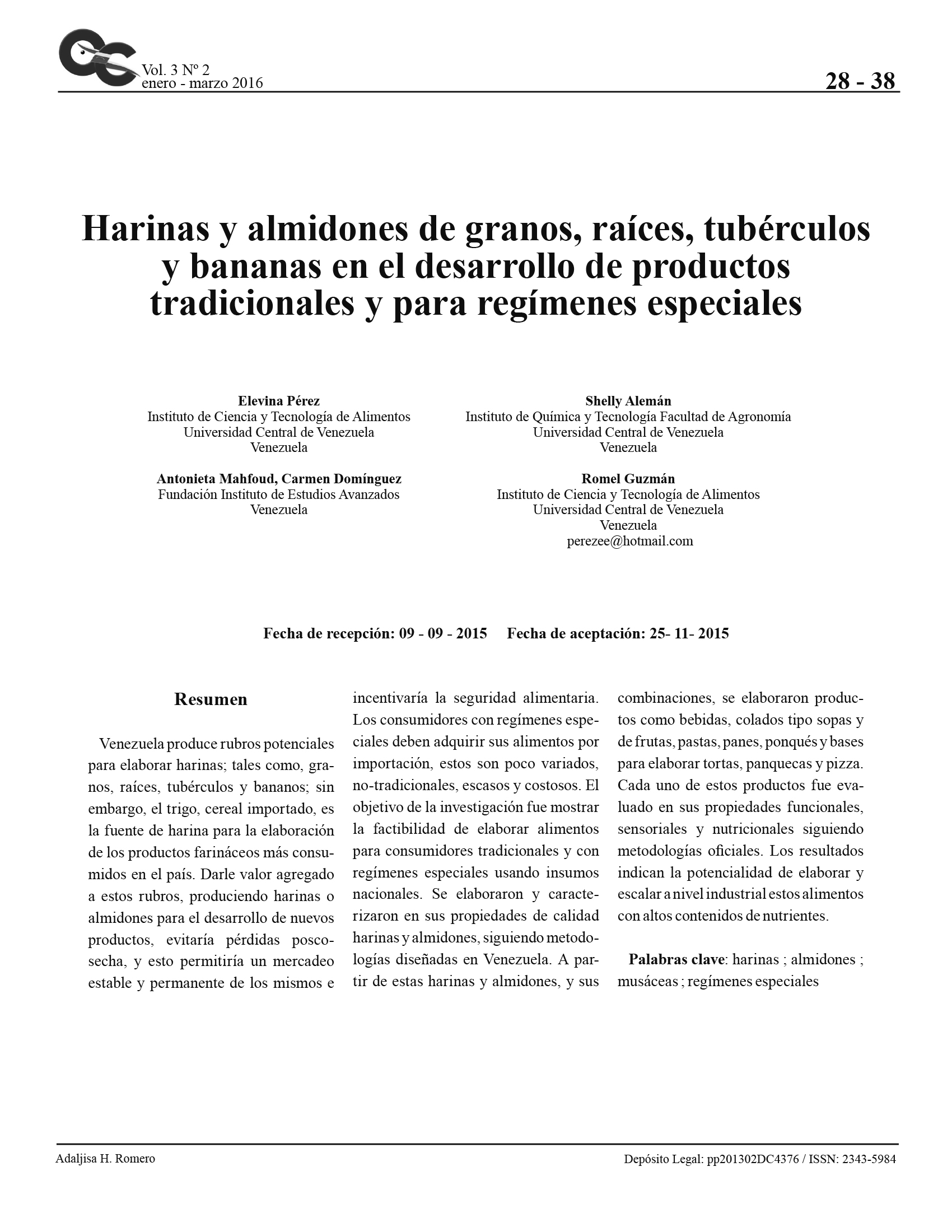Flours and starches grain, roots, tubers and bananas in the development of traditional products and special schemes
Keywords:
: flours, starches, musáceas, special schemesAbstract
Venezuela produces potential items to elaborate flours; such as, grains, roots, tubers and bananas; however, wheat, imported cereal, is the source of flour for the elaboration of the most consumed farinaceous products in the country. Giving added value to these items, producing flours or starches for the development of new products, would avoid post-harvest losses, and this would allow a stable and permanent marketing of them and would encourage food security. Consumers with special diets must purchase their food by import, which is not very varied, non-traditional, scarce and expensive. The objective of the research was to show the feasibility of producing food for traditional consumers and those with special diets using national inputs. Flours and starches were produced and characterized in terms of their quality properties, following methodologies designed in Venezuela. From these flours and starches, and their combinations, products such as beverages, soup and fruit strains, pastas, breads, ponchos and bases for making cakes, pancakes and pizza were elaborated. Each one of these products was evaluated in its functional, sensory and nutritional properties following official methodologies. The results indicate the potential of elaborating and scaling up these foods with high contents of nutrients at an industrial level.
Downloads
References
American Association of Cereal Chemists. (2003). Cereal Laboratory Approved Methods. St Paul, MN, Estados Unidos. Akissoé, N., Hounhouigan, J., Mestres, C. y Nago, M. (2003).
How blanching and drying affect the colour and functional characteristics of yam (Dioscores cayenensisi-rotundata) flour. Food Chemistry, 82(2): 57-264.
Association of Official Analytica.Chemist. (2000). Official Methods of Analysis. 17va. edición. Estados Unidos: Arai, S., Maeda, A., Matsumura, M., Hirao, N. y Watanabe, M.. (1986). Enlarged-scale production of low-phenylalanine peptide substances as a foodstuff for patients with phenilketonuria.
Agriculture and Biological Chemistry, 50(11): 2929-2931. Avanza, M., Puppo, M. y Añón, M. (2005). Rheological Characterization of amaranth protein gels. Food Hydrocolloids, 19(5): 889-898.
Bedolla, S. y Rooney, L. (1984) . Characteristics of U.S. and Mexican instant maize flours for tortilla and snack preparation. Cereal Foods World, 29(4): 732-735.
Cooke, R. (1978). An enzymatic assay for the total cyanide content of cassava (Manihot esculenta Crantz). Journal of Science and Food Agriculture, 29: 345-352.
Goñi, I., García, L., Mañas, E. y Saura, F. (1996). Analysis of resistant starch: a method for foods and food products. Food Chemistry, 56(4): 445-449.
Holm, J., Björck, I., Asp, N., Sjöberg, L. y Lundquist, I. (1985). Starch availability in vitro and in vivo after flaking, steamcooking and popping of wheat. Journal of Cereal Science, 3(3): 193-206.
Hsua, C-L., Wenlung, C., Menga, W-Y. y Tsenga, C-Y. (2003). Chemical composition. physical properties and antioxidant activities of yam flours as affected by different drying methods. Food Chemistry, 83(1): 85–92.
Hunter Lab. Manual. (2001). Hunter Associates Laboratory Universal software version 3.8 ISO 9001 certified. Recuperado de: www.hunterlab.com/colorflex-ez-user-manual.pdf
Instituto Nacional de Nutrición. (2001). Tabla de composición de los alimentos para uso práctico. Pub. Nº 54, Serie de Cuadernos Azules, Ministerio de Salud y Desarrollo Social, Caracas, Venezuela.
NOM-086-SSA1- (1994). Alimentos y bebidas no alcohólicas con modificaciones en su composición. Especificaciones nutrimentales. Recuperado de: www.salud.gob.mx/unidades/cdi/nom/086ssa14.html
Organización de la Naciones Unidas para la Alimentación y la Agricultura (FAO). (2008). Norma general para el etiquetado y declaración de propiedades de alimentos pre-envasados para regímenes especiales. CODEX-STAN-146-1985. Recuperado el 10 de septiembre de: http://www.fao.org/DOCREP/005/Y2770S/ y2770s04.htm
Pacheco-Delahaye, E., Maldonado, R., Pérez, E., Schroeder, M. (2008). Production and characterization of unripe plantain (Musa paradisiaca L) flours. Interciencia 33(4): 290-296.
Palomino, C., Molina, Y. y Pérez, E. (2010). Atributos físicos y composición química de harinas y almidones de los tubérculos de Colocasia esculenta (L.) Schott y Xanthosoma sagittifolium (L.)
Schott. Revista de la Facultad de Agronomía, UCV, 36(2): 58-66. Pérez, E., Gutiérrez, M.E., Pacheco de Delahaye, E., Tovar, J. y Lares, M. (2007). Production and characterization of Xanthosoma sagittifolium, and Colocassia esculenta flours. Journal of Food Science, 72(6): S367–S372.
Pérez, E. (1997). Characterization of starch isolated from plantain (Musa paradisiaca Normalis). StarchStärke, 49(2): 45-49.
Pérez, E. (2010). ¿Tecnología de alimentos en la Medicina? Perspectivas en Venezuela en la elaboración de productos de regímenes especiales. Tribuna de Investigador, 11(1-2): 6-10.
Pérez, E. y Pacheco de Delahaye, E. (2005). Características químicas, físicas y reológicas de la harina y el almidón nativo aislado de Ipomoea batatas Lam. Acta Científica, 56(1): 12-20.
Pérez Sira, E. (2007). Raíces y Tubérculos. En: A. León y C. Rosell. (Eds.). De tales harinas, tales panes. Granos harinas y productos de panificación en Iberoamérica. Programa Iberoamericano de Ciencia y Tecnología para el Desarrollo, (CYTED) Córdoba, Argentina. (pp. 363-401). Recuperado de: http://agro.unc.edu.ar/~uninvestigacion/Publicaciones_cyted. Htm
Skerritt, J. y Hill, A. (1990). Monoclonal antibody sandwich enzyme immunoassays for determination of gluten in oods.
Journal of Agricultural and Food Chemistry, 38(8): 1771-1778. Subramanian, S. y Viswanathan, R. (2007). Bulk density and
friction coefficients of selected minor millet grains and flours. Journal of Food Engineering, 8(1): 118-126.
Toricella, R., Zamora, E., Pulido, H. (2007). Evaluación sensorial aplicada a la investigación, desarrollo y control de calidad en la industria alimentaria. Cuba: Editorial universitaria.
Von Loesecke, H. (1950). Bananas. (2da edición). Nueva York: Interscience.

Downloads
Published
How to Cite
Issue
Section
License

This work is licensed under a Creative Commons Attribution-NoDerivatives 4.0 International License.







